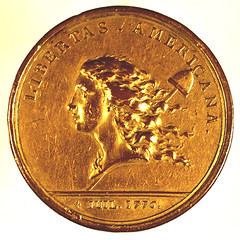
PREV ARTICLE
NEXT ARTICLE
FULL ISSUE
PREV FULL ISSUE
CAPPING LIBERTY: NUMISMATIC ICONOGRAPHY FOR THE NEW AMERICAN REPUBLIC
Alan M. Stahl, Princeton's Curator of Numismatics forwarded this press release about an interesting new exhibit.
-Editor
An Exhibition of Coins, Medals, Banknotes, and Related Books, Manuscripts, and Graphic Arts from Princeton University Collections Milberg Gallery, Firestone Library, March 3, 2012, to July 8, 2012 When the founders of the American Republic declared independence from Great Britain on July 4, 1776, one of the major tasks they took on was the creation of a coinage for the new nation. There were few precedents to guide them in choosing specific images to represent the ideals of their republican form of government as most existing coinage bore the image of a monarch. The leading figures in the process of selecting the numismatic imagery of the American Republic were Benjamin Franklin, Thomas Jefferson, and George Washington, each of whom made contributions that reflected personal background, attitudes, and ideals. Following a rancorous dispute between the Senate and the House of Representatives, the ultimate choice for the main image for the new coinage was "an impression emblematic of Liberty," which took the form of the head of a beautiful woman, sometimes accompanied by a cap derived from classical attributes of the Roman goddess Libertas. Together with the complementary attributes of an eagle and a wreath, this symbol came to exemplify the United States of America.
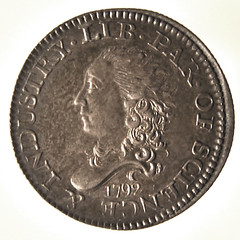
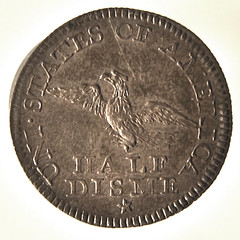
Silver half disme, 1792. The rich resources of Princeton University Library's Department of Rare Books and Special Collections serve as the basis of an exhibition entitled "Capping Liberty," which illustrates the search for imagery and the selection and adoption of symbols for a national coinage. "The star of the show will undoubtedly be the Princeton specimen of the 1792 'half disme'," predicts Alan Stahl, the exhibition's curator. This is a superb example of the first coin minted by the United States government under the Constitution. Delays in passing the Mint Act of 1792 left little time to strike coins that year, so a very small issue of half dismes (the old French spelling was used on the piece) was minted in a temporary facility, reputedly from silver supplied by George Washington for the purpose. Fewer than 2,000 examples are believed to have been struck. The Princeton specimen was purchased by Charles A. Cass, Class of 1904, from an auction in 1917, by Thomas Elder where it was described as "the finest known specimen of this exceedingly rare coin." It came to Princeton with the impressive Cass numismatic collection by bequest in 1958. The specimen has been characterized by Roger Siboni, president of the American Numismatic Society, as "perhaps the finest, or one of the finest 1792 half dismes in existence" in an article in Coin World (Sept. 1, 2008). Other important coins from the Princeton University Numismatic Collection in the exhibition are four issues of the seventeenth-century Massachusetts silver shilling coinage, two examples of the tin "Continental dollar" patterns of 1776, and a 1794 (14 star) silver dollar.
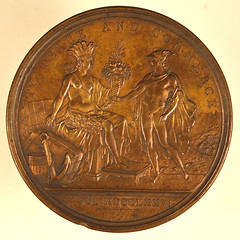
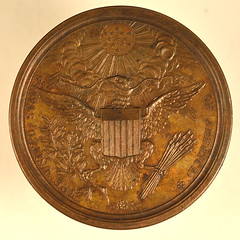
Augustin Dupré, Diplomatic Medal, bronze, 1791. The "poster piece" of the exhibition is the gilt bronze striking of Augustin Dupré's 1783 Libertas Americana medal, a gift of Rodman Wanamaker, Class of 1886, which is believed it have been the basis for the depiction of Liberty on the early United States coinage. It is accompanied by a selection of ancient coins that inspired it, including a Sicilian dekadrachm and a series of denarii of the Roman Republic and sestertii of the Empire that show the goddess Libertas and her distinctive cap. Other important medals in the exhibition are an original bronze striking of Dupré's Diplomatic Medal of 1791 (one of only three known), a gift of the scholar of ancient and American coinage Cornelius Vermeule III, and a hand-engraved medal believed to have been given to Henry "Light-Horse Harry" Lee (Princeton Class of 1773). Also on display are three unique plaster moulds made by Jean-Baptiste Nini as preparatory models for his famous terra-cotta medallions of Benjamin Franklin. Complementing the coins and medals from the Numismatic Collection are many items from other divisions of Princeton's Special Collection, including books formerly in the libraries of Benjamin Franklin, George Washington, and Thomas Jefferson. Among the depictions of Liberty from colonial publications is the portrait of John Hancock engraved in 1774 by Paul Revere, where the patriot is flanked by a knight with a copy of the Magna Charta and Liberty with her cap. In manuscript letters George Washington voices support for Jefferson's "Propositions Respecting the Coinage of Gold, Silver and Copper," and John Adams asks Mint Director Benjamin Rush (Princeton Class of 1760) for examples of United States coinage for his son John Quincy Adams to send to Russia. A 1778 print attributed to the painter Jean-Honoré Fragonard depicts Benjamin Franklin crowned by the goddess Liberty, and a large piece of Toile de Jouy fabric printed around 1785 has the image of George Washington in a gold chariot drawn by cheetahs.

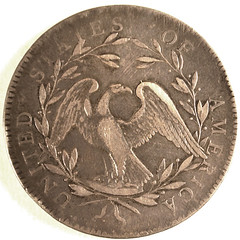
Silver dollar, 1794. On Sunday, May 6, the noted scholar of American colonial coinage, Louis Jordan, of the University of Notre Dame, will give a public lecture entitled "Transformations in Numismatic Iconography during the American Revolution" at 4 p.m. in 101 McCormick Hall on the Princeton campus. The lecture will be preceded at 2:30 by a curatorial tour of the exhibition in Firestone Library by Alan M. Stahl, Princeton's Curator of Numismatics. A reception in Firestone Library will follow the lecture. Additional curatorial tours will be held on Sunday, March 25, and Thursday, May 31, both at 2:30 p.m. The exhibition and its associated events are free and open to the public. A website devoted to the exhibition, including high-resolution images of both sides of all coins on display and images from the books, manuscripts, and graphic arts, is online at rbsc.princeton.edu/capping-liberty and will remain on the site after the close of the exhibition.
"Capping Liberty" runs from March 3, 2012, through July 8, 2012, in the Leonard L. Milberg Gallery of Firestone Library, Princeton University. Hours are Monday through Friday, 9 a.m. to 5 p.m., Saturday and Sunday, noon to 5 p.m., closed holidays. Further information can be obtained from Alan Stahl, Curator of Numismatics, at astahl@princeton.edu or (609) 258-9127.
The Numismatic Bibliomania Society is a non-profit organization promoting numismatic literature. See our web site at coinbooks.org. To submit items for publication in The E-Sylum, write to the Editor at this address: whomren@gmail.com To subscribe go to: https://my.binhost.com/lists/listinfo/esylum All Rights Reserved. NBS Home Page Contact the NBS webmaster 
|
